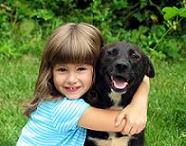Pets in Daycare

It is quite common to have pets in daycare. Many households have assorted pets (sometimes more than one) that are considered one-of-the-family.
Should you choose however, to open a home daycare when there are animals in your household, there are precautions you need to be aware of.
It is quite common to have pets in daycare. Many households have assorted pets (sometimes more than one) that are considered one-of-the-family.
Should you choose however, to open a home daycare when there are animals in your household, there are precautions you need to be aware of.
I will assume you have notified parents prior to admission that you have pets. I will also assume that the pets in your care are up-to-date on shots and license as required by your state.
Having that out of the way, there are several things to consider when mixing children with animals.
Pets in Daycare
Each state has separate guidelines on pets while providing care to children. Dogs and cats are generally accepted. Some states do not allow certain types of birds, while others have regulations against reptiles.
Minnesota, for example, does not allow reptiles of any kind. My son had a bearded dragon. This is a small lizard like creature. In any case, cute as we all thought it was, the dragon had to go live elsewhere so I could get the daycare license.
If an animal breaks the skin of a child (either by bite or scratch) it is mandated that the parents are notified the same day. Typically, the provider will need to take reasonable steps to contain the animal, and an agent from the Board of Health should be notified. Your County Health and Human Resources Department can give you more information on this issue.
*If you choose to have pets in daycare, realize that if your pet bites a daycare child, your regular homeowners policy will not cover you in the event of a lawsuit. Typically, neither will your homeowners liability insurance. You'll need a separate add-on to your policy.
_________________________________________________________________________
Some Thoughts on Mixing Children and Pets:
- Children learn from being around animals. One important benefit is that children talk to animals, thereby having a way to deal with their feelings. In helping to take care of a pet, they also develop responsible behavior.
- Supervision is necessary whenever animals and children are together. Children should never be left unattended around pets.
- When you have pets in daycare, children should be taught the basics of being around animals. Some children in your care may not have pets at home and do not understand how to act around animals. Others may be frightened of animals. Teach children by your own example. Children are very good at mimicking the behavior of adults. If you roughhouse with your large dog, a small child may think they can too.
- The younger the child, the more likely they are to treat an animal as though it is a toy. This makes the child more likely to be bitten or scratched.
- Teach a child never to bother an animal that is eating. Teach children to stroke animals, instead of petting them. To a young child petting an animal is very much like hitting.
- Pay attention to warning signs like hissing or growling that indicates you have an upset animal. Sometimes the signals are much quieter in nature. I have a cat that will back away and try to hide when he’s had enough. That’s my cue to remove him from the room.
- Make sure any animals have a place they can go to be alone (ex. doghouse, spare bedroom). Make sure this area is off limits to children.
- Combining children with pets can be accomplished if common sense rules are followed.
_________________________________________________________________________

More Articles:
_________________________________________________________________________
 | Fun Activities for Kids |
_________________________________________________________________________
from pets in daycare to daycare tips
from pets in daycare to simply daycare home
















